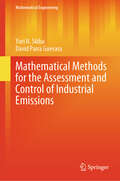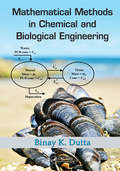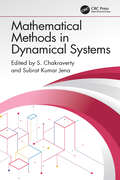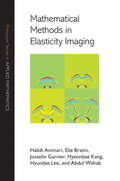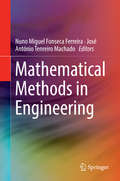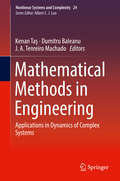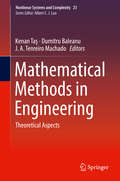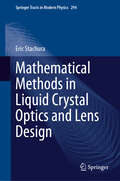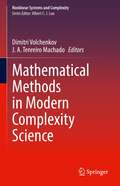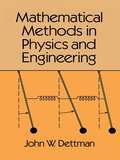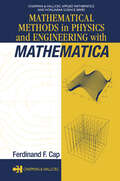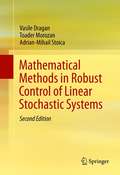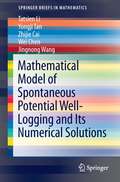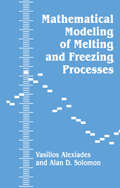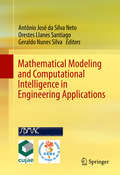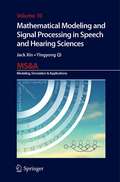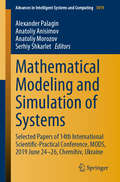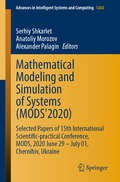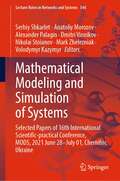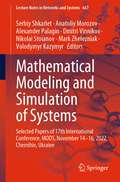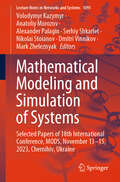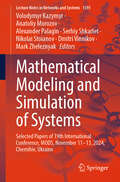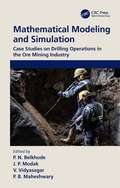- Table View
- List View
Mathematical Methods for the Assessment and Control of Industrial Emissions (Mathematical Engineering)
by Yuri N. Skiba David Parra GuevaraThis book delves onto modern mathematical methods aimed at mitigating environmental pollution risks caused by industrial activities. Showing the alarming global issue of industrial pollution, the text explores the complexities of emission control strategies and dispersion models. Through a systematic approach, readers will gain insights into the utilization of mathematical models to assess pollutant dispersion, regulate emissions, and pinpoint sources of excessive pollution. With a focus on averting health risks and ensuring compliance with sanitary standards, the book elucidates the application of control strategies to manage pollutant concentrations effectively. From differential equations to optimization theory, the narrative navigates through interdisciplinary concepts, offering a wealth of knowledge for researchers, professionals, and students alike. Chapters brim with illustrative examples, shedding light on air and marine pollution control, while emphasizing the versatility of the discussed strategies. Whether tackling two-dimensional or three-dimensional dispersion models, the book equips readers with essential tools to confront the pressing challenges of industrial pollution in both developed and developing regions.
Mathematical Methods in Chemical and Biological Engineering
by Binay Kanti DuttaMathematical Methods in Chemical and Biological Engineering describes basic to moderately advanced mathematical techniques useful for shaping the model-based analysis of chemical and biological engineering systems. Covering an ideal balance of basic mathematical principles and applications to physico-chemical problems, this book presents examples drawn from recent scientific and technical literature on chemical engineering, biological and biomedical engineering, food processing, and a variety of diffusional problems to demonstrate the real-world value of the mathematical methods. Emphasis is placed on the background and physical understanding of the problems to prepare students for future challenging and innovative applications.
Mathematical Methods in Dynamical Systems
by S. Chakraverty Subrat Kumar JenaThe art of applying mathematics to real-world dynamical problems such as structural dynamics, fluid dynamics, wave dynamics, robot dynamics, etc. can be extremely challenging. Various aspects of mathematical modelling that may include deterministic or uncertain (fuzzy, interval, or stochastic) scenarios, along with integer or fractional order, are vital to understanding these dynamical systems. Mathematical Methods in Dynamical Systems offers problem-solving techniques and includes different analytical, semi-analytical, numerical, and machine intelligence methods for finding exact and/or approximate solutions of governing equations arising in dynamical systems. It provides a singular source of computationally efficient methods to investigate these systems and includes coverage of various industrial applications in a simple yet comprehensive way.
Mathematical Methods in Elasticity Imaging
by Elie Bretin Abdul Wahab Hyeonbae Kang Habib Ammari Hyundae Lee Josselin GarnierThis book is the first to comprehensively explore elasticity imaging and examines recent, important developments in asymptotic imaging, modeling, and analysis of deterministic and stochastic elastic wave propagation phenomena. It derives the best possible functional images for small inclusions and cracks within the context of stability and resolution, and introduces a topological derivative-based imaging framework for detecting elastic inclusions in the time-harmonic regime. For imaging extended elastic inclusions, accurate optimal control methodologies are designed and the effects of uncertainties of the geometric or physical parameters on stability and resolution properties are evaluated. In particular, the book shows how localized damage to a mechanical structure affects its dynamic characteristics, and how measured eigenparameters are linked to elastic inclusion or crack location, orientation, and size. Demonstrating a novel method for identifying, locating, and estimating inclusions and cracks in elastic structures, the book opens possibilities for a mathematical and numerical framework for elasticity imaging of nanoparticles and cellular structures.
Mathematical Methods in Engineering
by Joseph M. Powers Mihir SenThis text focuses on a variety of topics in mathematics in common usage in graduate engineering programs including vector calculus, linear and nonlinear ordinary differential equations, approximation methods, vector spaces, linear algebra, integral equations and dynamical systems. The book is designed for engineering graduate students who wonder how much of their basic mathematics will be of use in practice. Following development of the underlying analysis, the book takes students step-by-step through a large number of examples that have been worked in detail. Students can choose to go through each step or to skip ahead if they so desire. After seeing all the intermediate steps, they will be in a better position to know what is expected of them when solving homework assignments, examination problems, and when they are on the job. Each chapter concludes with numerous exercises for the student that reinforce the chapter content and help connect the subject matter to a variety of engineering problems. Students today have grown up with computer-based tools including numerical calculations and computer graphics; the worked-out examples as well as the end-of-chapter exercises often use computers for numerical and symbolic computations and for graphical display of the results.
Mathematical Methods in Engineering
by Nuno Miguel Fonseca Ferreira José António Tenreiro MachadoThis book presents a careful selection of the contributions presented at the Mathematical Methods in Engineering (MME10) International Symposium, held at the Polytechnic Institute of Coimbra- Engineering Institute of Coimbra (IPC/ISEC), Portugal, October 21-24, 2010. The volume discusses recent developments about theoretical and applied mathematics toward the solution of engineering problems, thus covering a wide range of topics, such as: Automatic Control, Autonomous Systems, Computer Science, Dynamical Systems and Control, Electronics, Finance and Economics, Fluid Mechanics and Heat Transfer, Fractional Mathematics, Fractional Transforms and Their Applications, Fuzzy Sets and Systems, Image and Signal Analysis, Image Processing, Mechanics, Mechatronics, Motor Control and Human Movement Analysis, Nonlinear Dynamics, Partial Differential Equations, Robotics, Acoustics, Vibration and Control, and Wavelets.
Mathematical Methods in Engineering and Applied Sciences (Mathematics and its Applications)
by Hemen DuttaThis book covers tools and techniques used for developing mathematical methods and modelling related to real-life situations. It brings forward significant aspects of mathematical research by using different mathematical methods such as analytical, computational, and numerical with relevance or applications in engineering and applied sciences. Presents theory, methods, and applications in a balanced manner Includes the basic developments with full details Contains the most recent advances and offers enough references for further study Written in a self-contained style and provides proof of necessary results Offers research problems to help early career researchers prepare research proposals Mathematical Methods in Engineering and Applied Sciences makes available for the audience, several relevant topics in one place necessary for crucial understanding of research problems of an applied nature. This should attract the attention of general readers, mathematicians, and engineers interested in new tools and techniques required for developing more accurate mathematical methods and modelling corresponding to real-life situations.
Mathematical Methods in Engineering: Applications in Dynamics of Complex Systems (Nonlinear Systems and Complexity #24)
by Dumitru Baleanu Kenan Taş J. A. MachadoThis book presents recent developments in nonlinear dynamics with an emphasis on complex systems. The volume illustrates new methods to characterize the solutions of nonlinear dynamics associated with complex systems. This book contains the following topics: new solutions of the functional equations, optimization algorithm for traveling salesman problem, fractals, control, fractional calculus models, fractional discretization, local fractional partial differential equations and their applications, and solutions of fractional kinetic equations.
Mathematical Methods in Engineering: Theoretical Aspects (Nonlinear Systems and Complexity #23)
by Dumitru Baleanu Kenan Taş J. A. MachadoThis book collects chapters dealing with some of the theoretical aspects needed to properly discuss the dynamics of complex engineering systems. The book illustrates advanced theoretical development and new techniques designed to better solve problems within the nonlinear dynamical systems. Topics covered in this volume include advances on fixed point results on partial metric spaces, localization of the spectral expansions associated with the partial differential operators, irregularity in graphs and inverse problems, Hyers-Ulam and Hyers-Ulam-Rassias stability for integro-differential equations, fixed point results for mixed multivalued mappings of Feng-Liu type on Mb-metric spaces, and the limit q-Bernstein operators, analytical investigation on the fractional diffusion absorption equation.
Mathematical Methods in Liquid Crystal Optics and Lens Design (Springer Tracts in Modern Physics #294)
by Eric StachuraFreeform lens design has numerous applications in imaging, aerospace, and biomedicine. Due to recent advancements in precision cutting and grinding, the manufacturing of freeform optical lenses with very high precision is now possible. However, there is still a significant lack of mathematical literature on the subject, and essentially none related to liquid crystals. Liquid crystals are appealing for use in imaging due to their flexibility and unique electro-optical properties. This book fills a gap in mathematical literature and attracts focus to liquid crystals for freeform lens design. It provides a rigorous mathematical perspective on liquid crystal optics, focusing on ray tracing in the geometric optics regime. A mathematical foundation is set to study lens design and ray tracing problems in liquid crystals. Additionally, it addresses absolute instruments, which are devices that image without any optical aberrations. These instruments cannot be designed through transformation optics, and until recently, only a handful of examples were known. Mathematically, this is a largely untapped area of research, yet the applications are profound. Finally, the book describes several open directions, revealing the richness of the intersection of liquid crystal optics and mathematical analysis. The content of this book will prove invaluable for researchers of mathematical optics as well as those interested in liquid crystal theory, in addition to those mathematics graduate students aiming to understand the physical basis of light propagation in liquid crystals
Mathematical Methods in Modern Complexity Science (Nonlinear Systems and Complexity #33)
by Dimitri Volchenkov J. A. Tenreiro MachadoThis book presents recent developments in nonlinear and complex systems. It provides recent theoretic developments and new techniques based on a nonlinear dynamical systems approach that can be used to model and understand complex behavior in nonlinear dynamical systems. It covers information theory, relativistic chaotic dynamics, data analysis, relativistic chaotic dynamics, solvability issues in integro-differential equations, and inverse problems for parabolic differential equations, synchronization and chaotic transient. Presents new concepts for understanding and modeling complex systems
Mathematical Methods in Physics and Engineering (Dover Books on Physics)
by John W. DettmanIntended for college-level physics, engineering, or mathematics students, this volume offers an algebraically based approach to various topics in applied math. It is accessible to undergraduates with a good course in calculus which includes infinite series and uniform convergence. Exercises follow each chapter to test the student's grasp of the material; however, the author has also included exercises that extend the results to new situations and lay the groundwork for new concepts to be introduced later. A list of references for further reading will be found at the end of each chapter. For this second revised edition, Professor Dettman included a new section on generalized functions to help explain the use of the Dirac delta function in connection with Green's functions. In addition, a new approach to series solutions of ordinary differential equations has made the treatment independent of complex variable theory. This means that the first six chapters can be grasped without prior knowledge of complex variables. However, since Chapter 8 depends heavily on analytic functions of a complex variable, a new Chapter 7 on analytic function theory has been written.
Mathematical Methods in Physics and Engineering with Mathematica (Chapman & Hall/CRC Applied Mathematics & Nonlinear Science)
by Ferdinand F. CapMore than ever before, complicated mathematical procedures are integral to the success and advancement of technology, engineering, and even industrial production. Knowledge of and experience with these procedures is therefore vital to present and future scientists, engineers and technologists.Mathematical Methods in Physics and Engineering
Mathematical Methods in Robust Control of Linear Stochastic Systems
by Vasile Dragan Toader Morozan Adrian-Mihail StoicaThis second edition of Mathematical Methods in the Robust Control of Linear Stochastic Systems includes a large number of recent results in the control of linear stochastic systems. More specifically, the new results presented are: - A unified and abstract framework for Riccati type equations arising in the stochastic control - Stability and control problems for systems perturbed by homogeneous Markov processes with infinite number of states - Mixed H2 / H∞ control problem and numerical procedures - Linear differential equations with positive evolution on ordered Banach spaces with applications for stochastic systems including both multiplicative white noise and Markovian jumps represented by a Markov chain with countable infinite set of states - Kalman filtering for stochastic systems subject both to state dependent noise and Markovian jumps - H∞ reduced order filters for stochastic systems The book will appeal to graduate students, researchers in advanced control engineering, finance, mathematical systems theory, applied probability and stochastic processes, and numerical analysis. From Reviews of the First Edition: This book is concerned with robust control of stochastic systems. One of the main features is its coverage of jump Markovian systems. . . . Overall, this book presents results taking into consideration both white noise and Markov chain perturbations. It is clearly written and should be useful for people working in applied mathematics and in control and systems theory. The references cited provide further reading sources. (George Yin, Mathematical Reviews, Issue 2007 m) This book considers linear time varying stochastic systems, subjected to white noise disturbances and system parameter Markovian jumping, in the context of optimal control . . . robust stabilization, and disturbance attenuation. . . . The material presented in the book is organized in seven chapters. . . . The book is very well written and organized. . . . is a valuable reference for all researchers and graduate students in applied mathematics and control engineering interested in linear stochastic time varying control systems with Markovian parameter jumping and white noise disturbances. (Zoran Gajic, SIAM Review, Vol. 49 (3), 2007)
Mathematical Model of Spontaneous Potential Well-Logging and Its Numerical Solutions
by Wei Chen Tatsien Li Yongji Tan Zhijie Cai Jingnong WangSpontaneous potential (SP) well-logging is one of the most common and useful well-logging techniques in petroleum exploitation. This monograph is the first of its kind on the mathematical model of spontaneous potential well-logging and its numerical solutions. The mathematical model established in this book shows the necessity of introducing Sobolev spaces with fractional power, which seriously increases the difficulty of proving the well-posedness and proposing numerical solution schemes. In this book, in the axisymmetric situation the well-posedness of the corresponding mathematical model is proved and three efficient schemes of numerical solution are proposed, supported by a number of numerical examples to meet practical computation needs.
Mathematical Modeling Of Melting And Freezing Processes
by V. AlexiadesThis reference book presents mathematical models of melting and solidification processes that are the key to the effective performance of latent heat thermal energy storage systems (LHTES), utilized in a wide range of heat transfer and industrial applications. This topic has spurred a growth in research into LHTES applications in energy conservation and utilization, space station power systems, and thermal protection of electronic equipment in hostile environments. Further, interest in mathematical modeling has increased with the speread of high powered computers used in most industrial and academic settings. In two sections, the book first describes modeling of phase change processes and then describes applications for LHTES. It is aimed at graduate students, researchers, and practicing engineers in heat transfer, materials processing, multiphase systems, energy conservation, metallurgy, microelectronics, and cryosurgery.
Mathematical Modeling and Computational Intelligence in Engineering Applications
by Antônio José da Silva Neto Orestes Llanes Santiago Geraldo Nunes SilvaThis book brings together a rich selection of studies in mathematical modeling and computational intelligence, with application in several fields of engineering, like automation, biomedical, chemical, civil, electrical, electronic, geophysical and mechanical engineering, on a multidisciplinary approach. Authors from five countries and 16 different research centers contribute with their expertise in both the fundamentals and real problems applications based upon their strong background on modeling and computational intelligence. The reader will find a wide variety of applications, mathematical and computational tools and original results, all presented with rigorous mathematical procedures. This work is intended for use in graduate courses of engineering, applied mathematics and applied computation where tools as mathematical and computational modeling, numerical methods and computational intelligence are applied to the solution of real problems.
Mathematical Modeling and Signal Processing in Speech and Hearing Sciences (Ms&a Ser. #10)
by Jack Xin Yingyong QiThe aim of the book is to give an accessible introduction of mathematical models and signal processing methods in speech and hearing sciences for senior undergraduate and beginning graduate students with basic knowledge of linear algebra, differential equations, numerical analysis, and probability. Speech and hearing sciences are fundamental to numerous technological advances of the digital world in the past decade, from music compression in MP3 to digital hearing aids, from network based voice enabled services to speech interaction with mobile phones. Mathematics and computation are intimately related to these leaps and bounds. On the other hand, speech and hearing are strongly interdisciplinary areas where dissimilar scientific and engineering publications and approaches often coexist and make it difficult for newcomers to enter.
Mathematical Modeling and Simulation of Systems: Selected Papers of 14th International Scientific-Practical Conference, MODS, 2019 June 24-26, Chernihiv, Ukraine (Advances in Intelligent Systems and Computing #1019)
by Alexander Palagin Anatoliy Anisimov Anatoliy Morozov Serhiy ShkarletThis book presents current investigations in the field of mathematical modeling and simulation to support the development of intelligent information systems in domains such as ecology and geology, manufacturing, project management, and safety of distributed information systems. The book will be of interest to developers of modern high-tech software complexes for situational control centers, based on mathematical modeling and simulation methods. In addition, it will appeal to software engineers and programmers, offering them new implementation and application methods. Gathering the latest research, prepared by leading scholars, and identifying promising new directions for solving complex scientific and practical problems, the book presents selected outcomes of the 14th International Scientific-Practical Conference, MODS2019, held in Chernihiv, Ukraine, on June 24 to 26, 2019.
Mathematical Modeling and Simulation of Systems: Selected Papers of 15th International Scientific-practical Conference, MODS, 2020 June 29 – July 01, Chernihiv, Ukraine (Advances in Intelligent Systems and Computing #1265)
by Alexander Palagin Anatoliy Morozov Serhiy ShkarletThis book contains works on mathematical and simulation modeling of processes in various domains: ecology and geographic information systems, IT, industry, and project management. The development of complex multicomponent systems requires an increase in accuracy, efficiency, and adequacy while reducing the cost of their creation.The studies presented in the book are useful to specialists who are involved in the development of real events models: analog, management and decision-making models, production models, and software products. Scientists can get acquainted with the latest research in various decisions proposed by leading scholars and identify promising directions for solving complex scientific and practical problems. The chapters of this book contain the contributions presented on the 15th International Scientific-Practical Conference, MODS, June 29–July 01, 2020, Chernihiv, Ukraine.
Mathematical Modeling and Simulation of Systems: Selected Papers of 16th International Scientific-practical Conference, MODS, 2021 June 28–July 01, Chernihiv, Ukraine (Lecture Notes in Networks and Systems #344)
by Alexander Palagin Anatoliy Morozov Serhiy Shkarlet Dmitri Vinnikov Nikolai Stoianov Mark Zhelezniak Volodymyr KazymyrThis book contains works on mathematical and simulation modeling of processes in various domains: ecology and geographic information systems, IT, industry, and project management. The development of complex multicomponent systems requires an increase in accuracy, efficiency, and adequacy while reducing the cost of their creation. The studies presented in the book are useful to specialists who involved in the development of real events models-analog, management and decision-making models, production models, and software products. Scientists can get acquainted with the latest research in various decisions proposed by leading scholars and identify promising directions for solving complex scientific and practical problems. The chapters of this book contain the contributions presented on the 16th International Scientific-practical Conference, MODS, June 28–July 01, 2021, Chernihiv, Ukraine.
Mathematical Modeling and Simulation of Systems: Selected Papers of 17th International Conference, MODS, November 14-16, 2022, Chernihiv, Ukraine (Lecture Notes in Networks and Systems #667)
by Alexander Palagin Anatoliy Morozov Serhiy Shkarlet Dmitri Vinnikov Nikolai Stoianov Mark Zhelezniak Volodymyr KazymyrModern complex multi-domain systems require increased efficiency, reliability, and availability combined with reduced cost. This book contains papers on mathematical modeling and simulation of processes in various areas: ecology and the environment, production and energy, information technology, samples of special-purpose equipment, and cyber-physical systems. The outcomes presented in the book are useful to specialists involved in the modeling and simulation of real-world system, management and decision-making models, production models, and software products. Scientists have the opportunity to familiarize themselves with the latest research in a variety of solutions proposed by leading scientists and to determine promising directions for solving complex scientific and practical tasks. Chapters of this book contain papers presented at the 17th MODS International Conference, November 14–16, 2022, Chernihiv, Ukraine.
Mathematical Modeling and Simulation of Systems: Selected Papers of 18th International Conference, MODS, November 13-15, 2023, Chernihiv, Ukraine (Lecture Notes in Networks and Systems #1091)
by Alexander Palagin Anatoliy Morozov Serhiy Shkarlet Dmitri Vinnikov Nikolai Stoianov Volodymyr Kazymyr Mark ZheleznyakModern complex multi-domain systems require increased efficiency, reliability and availability combined with reduced cost. This book contains papers on mathematical modeling and simulation of processes in various areas: in ecology and the environment, production and energy, information technology, samples of special purpose equipment, and cyber-physical systems. The outcomes presented in the book will be useful to specialists involved in the modeling and simulation of real-world system, management and decision-making models, production models, and software products. Scientists have the opportunity to familiarize themselves with the latest research in a variety of solutions proposed by leading scientists and to determine promising directions for solving complex scientific and practical tasks. Chapters of this book contain papers presented at the 18th MODS International Conference, November 13–15, 2023, Chernihiv, Ukraine.
Mathematical Modeling and Simulation of Systems: Selected Papers of 19th International Conference, MODS, November 11–13, 2024, Chernihiv, Ukraine (Lecture Notes in Networks and Systems #1391)
by Alexander Palagin Anatoliy Morozov Serhiy Shkarlet Dmitri Vinnikov Nikolai Stoianov Volodymyr Kazymyr Mark ZheleznyakThis book contains papers on mathematical modeling and simulation of processes in various areas: in ecology and the environment, manufacturing and energetics, information technology, samples of special purpose equipment and cyber-physical systems. In the context of comprehensive digitalization, computer modeling becomes a direct component of creating and operating modern complex multi-domain systems. The outcomes presented in the book will be useful to specialists involved in the modeling of real-world and cyber-physical systems, physical processes simulation, management and decision-making models, functioning and cybersecurity models, modeling software and tools. Scientists have the opportunity to familiarize themselves with the latest research in a variety of solutions proposed by leading scientists and to determine promising directions for solving complex scientific and practical tasks. Chapters of this book contain papers presented at the 19th MODS International Conference, November 11–13, 2024, Chernihiv, Ukraine.
Mathematical Modeling and Simulation: Case Studies on Drilling Operations in the Ore Mining Industry
by Dr P. N. BelkhodeThis book explains the concept of man-machine systems by using the mining industry. The goal is to use a mathematical model based approach to improve the quality of human life of the workers and operators with the enhancement of productivity by controlling the process variables. The book will illustrate the formulation of mathematical modelling for manual operations. It will provide details in the investigation of many machine systems through the case study approach and provide data analysis using the concept of mathematical modelling and sensitivity. It presents how to solve a field problem through a field data-based modelling concept and highlights the collection of anthropometry data and its behavior. The book will be useful for researchers, academic libraries, professionals, post graduate students of Industrial, Mechanical, and Manufacturing Engineering programs.
